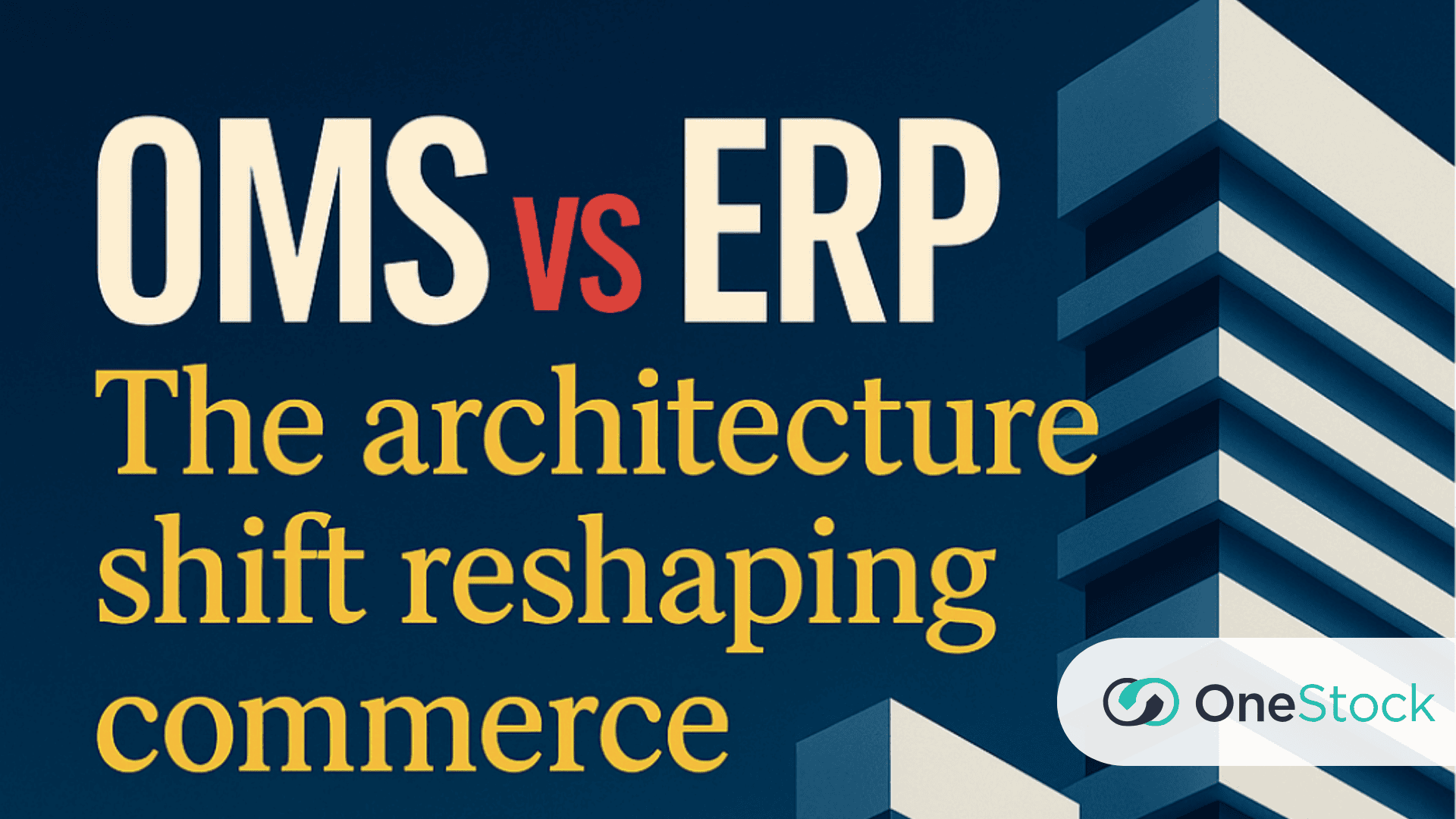
OMS vs ERP: The architecture shift reshaping commerce
Why this matters now
Your ERP runs your business. It manages financials, procurement, manufacturing, HR, and supply chain planning. It’s the system of record for everything that matters to enterprise operations.
So why are commerce leaders increasingly deploying Order Management Systems alongside their ERPs, often at seven-figure investments?
Because ERPs weren’t built for what commerce has become: distributed inventory across multiple stock locations (stores and warehouses), marketplace orders, same-day real-time delivery promises, real-time fulfillment decisions, multiple order allocation scenarios (Ship from Store, multi leg shipment, batch allocation), and customers who expect Amazon-level reliability from every brand.
This isn’t about replacing ERP. It’s about augmenting it with a specialized orchestration layer that can handle what modern fulfillment demands. Critically, OMS (or DOM, Distributed Order Management) decouples order orchestration and inventory availability from ERP, reducing dependency on ERP customization and making future ERP replatforming easier. The OMS sits between ERP and customer-facing channels as a real-time orchestration layer.
The functional reality: what each system actually does
ERP: the enterprise backbone
Enterprise Resource Planning systems emerged from manufacturing requirements planning (MRP) and expanded to cover the full operational scope of large organizations. SAP defines its ERP offering as software that “integrates core business processes such as finance, HR, and supply chain into one complete system” to create a single source of truth across functions.
ERPs excel at:
- Financial management and governance: GL, AP/AR, budgeting, compliance
- Supply chain planning: Demand forecasting, procurement, supplier management
- Manufacturing operations: Production scheduling, BOM management, quality control
- Human resources: Payroll, benefits, workforce planning
- Master data management: SKUs, pricing, vendor records, organizational hierarchies
What ERPs deliver is stability, auditability, and cross-functional integration. They’re designed for transactional integrity and process consistency at scale.
OMS: the fulfillment orchestrator
An Order Management System is purpose-built for one thing: optimizing how orders flow from placement to delivery across distributed fulfillment networks.
Core OMS capabilities:
- Real-time inventory visibility across stores, warehouses, 3PLs, and suppliers
- Dynamic order routing based on stock location, delivery promise, cost, and business rules
- Intelligent order splitting to minimize shipments while meeting customer expectations
- Multi-fulfillment options: Ship from Store, Click and Collect, dropship
- Delivery promise management: calculate and guarantee accurate ETAs at order placement
- Returns orchestration: route returns to optimal locations, manage refunds, handle exchanges
- Exception handling: reroute orders when stockouts or delays occur
The OMS sits between commerce channels (web, mobile, marketplaces, POS) and execution systems (WMS, TMS, carriers), making fulfillment decisions in real-time.
Where ERP struggles with modern commerce
- Architectural constraints
ERPs update inventory in batch cycles, hourly or nightly in many implementations. This worked when orders flowed through centralized distribution centers on predictable timelines.
It breaks when:
– A customer browses your website while stores are simultaneously selling the same SKU
– You need to promise delivery times based on current carrier capacity and cut-off windows
– Orders arrive from multiple channels simultaneously, requiring instant allocation decisions
Real-time commerce needs real-time orchestration. ERP batch cycles create visibility gaps that lead to oversells and broken promises.
- Limited fulfillment logic
ERP order modules typically handle allocation through simple rules: “fulfill from warehouse A, then warehouse B.” They weren’t designed for:
– “Ship from the store closest to the customer”
– “Split this order across three locations to meet the delivery promise”
– “Prefer stores with excess inventory to rebalance stock levels”
ERP isn’t broken. It’s just not built for everything. The system was designed for process consistency, not fulfillment optimization.
“Before implementing OneStock, we were really tied to our ERPs. If a customer came to the store to order a book and a CD, we had to create two separate orders and two customer accounts because everything was completely siloed.”
Séverine Candau, IT Domain Manager, Cultura
- Omnichannel complexity
Ship from Store, BOPIS, BORIS, marketplace fulfillment, these weren’t considerations when most ERPs were architected.
Retrofitting these capabilities often means:
– Expensive customization that becomes rigid and difficult to maintain
– Workarounds that fragment data and create inconsistencies
– Slow deployment cycles that can’t keep pace with customer expectations
Store fulfillment introduces additional complexity that ERPs struggle to handle. When stores become fulfillment nodes, they need seamless integration with carrier connector systems to generate shipping labels, track parcels, and manage pickup logistics. Beyond connectivity, the user experience for store associates becomes critical to operational efficiency and profitability. ERPs typically lack native carrier connectivity and real-time rate shopping capabilities, and their interfaces were designed for back-office users, not frontline retail staff processing orders between customer interactions. An OMS provides pre-built carrier integrations (FedEx, UPS, DHL, local couriers) that enable stores to quickly generate shipping labels, compare rates, track shipments in real-time, and handle exceptions like failed deliveries. Critically, modern OMS platforms deliver intuitive, mobile-optimized interfaces that allow store associates to fulfill orders in seconds rather than minutes, reducing training time, minimizing errors, and ensuring staff can maintain excellent customer service while managing fulfillment tasks. This carrier orchestration layer combined with purpose-built user experiences is essential for Ship from Store operations but requires extensive custom development in most ERP systems.
- Agility gap
Commerce requirements change constantly. New marketplaces launch. Promotional strategies shift. Carrier networks evolve. Customer expectations reset.
ERP changes are typically:
– Slow (months for significant changes)
– Risky (touching core business logic)
– Expensive (development, testing, governance)
– Rigid once deployed
Modern commerce needs configurability: the ability to adjust orchestration rules without code deployments.
Beyond agility in rule configuration, OMS addresses two critical infrastructure challenges:
- Scalability as a business enabler: An OMS acts as a hub architecture designed specifically for scalable growth. It facilitates the rapid connection of new stock locations (new stores, warehouses, dark stores), new sales channels (marketplaces, social commerce, B2B portals), and even new ERPs (common during acquisitions or mergers). This hub is architected for real-time communication across all nodes, exposing unified inventory, calculating availability, and delivering accurate promises instantly. While ERP integration projects typically take months and require heavy customization, an OMS can onboard a new fulfillment node or channel in days or weeks through standardized API patterns.
- AI-native capabilities: Modern OMS platforms are built with native AI capabilities that transform operational efficiency across multiple dimensions. These AI features support new conversational commerce protocols (enabling chatbots and voice assistants to check real-time availability and promise delivery), assist OMS users in daily tasks (configuration wizards, intelligent troubleshooting, anomaly detection), optimize warehouse operations (AI-driven pick-pack-ship process recommendations), streamline order management (predicting exceptions before they occur, suggesting optimal resolution paths), and deliver advanced performance analysis (identifying fulfillment bottlenecks, forecasting demand patterns, recommending routing rule adjustments). ERP systems, built on legacy architectures, typically don’t provide these AI capabilities natively and require extensive custom development or third-party bolt-ons to achieve similar functionality.
The OMS-ERP symbiosis: how they work together
The answer isn’t choosing between them. Leading organizations deploy both, with clear architectural boundaries:
ERP remains the system of record for:
- Financial transactions and accounting
- Master data (products, pricing, hierarchies)
- Supply chain planning and procurement
- Resource management and operations
OMS becomes the order orchestration engine for:
- Order routing and fulfillment decisions
- Real-time unified inventory
- Customer delivery promises
- Returns and reverse logistics
- Fulfillment optimization with carrier management
Think of it this way: ERP tells you what you have and where it is. OMS decides how to fulfill each order optimally regarding your business imperatives and where the stock is.
Data ownership and mastery
In a well-architected OMS-ERP integration, data ownership must be clearly defined to avoid conflicts and ensure single sources of truth:
- ERP is the master for product data (if no dedicated PIM system exists), inventory data (physical stock positions at each location), pricing rules and structures.
- OMS is the master for enterprise inventory availability (real-time available-to-promise calculations across all nodes and channels), order status and fulfillment state (order lifecycle, allocation decisions, routing history), delivery promises and customer commitments.
This separation ensures that while ERP maintains the authoritative record of physical inventory and financial data, OMS owns the real-time orchestration layer, calculating what can be promised to customers based on current allocation, reservations, and fulfillment capacity. Synchronization happens through event-driven patterns where inventory movements in ERP trigger updates to OMS availability calculations, and OMS fulfillment events update ERP financial and inventory records.
Integration architecture
Modern implementations connect through APIs and event-driven patterns:
- Master data flows from ERP to OMS: Products, pricing, locations, stock quantities
- Orders enter OMS from commerce systems: Web, mobile, POS, EDI, marketplaces
- OMS orchestrates fulfillment: Allocates inventory, generates fulfillment instructions
- Execution systems process orders: WMS, TMS, carriers receive instructions from OMS
- Fulfillment events update both systems: OMS tracks progress, ERP records financial impact and stock movements
This loose coupling allows each system to evolve independently while maintaining data consistency.
ERP vs OMS, the hybrid approach
| Capability | ERP excels at | OMS excels at | Depends on business complexity |
| Financial management | General ledger, accounts payable/receivable, financial reporting, compliance, audit trails | ||
| Supply chain planning | Demand forecasting, procurement, supplier relationship management, purchase orders | ||
| Manufacturing operations | Production scheduling, bill of materials, quality control, resource planning | ||
| Master data governance | Product catalog, pricing structures, vendor records, organizational hierarchies (when no dedicated PIM exists) | ||
| Inventory recording | Physical stock positions, inventory valuation, stock movements for financial purposes | ||
| Real-time inventory visibility | Unified available-to-promise across all fulfillment nodes, real-time reservations and allocations | ||
| Order routing and orchestration | Dynamic allocation using complex business rules, intelligent order splitting, cost-optimized routing | ||
| Delivery promise accuracy | Real-time ETA calculation based on current carrier capacity, cut-off times, and multi-node fulfillment scenarios | ||
| Omnichannel fulfillment | Ship from Store, BOPIS, BORIS, marketplace fulfillment | ||
| Carrier management | Multi-carrier integration, real-time rate shopping, label generation, shipment tracking, exception handling | ||
| Fulfillment exception handling | Real-time order rerouting, automated stockout management, proactive customer communication | ||
| Scalability for commerce | Rapid onboarding of new sales channels, stock locations, and even new ERPs | ||
| AI-driven capabilities | Conversational commerce support, intelligent configuration assistance, predictive exception management, optimization recommendations | ||
| Returns orchestration | Intelligent return routing, refurbishment workflows, cross-channel return experiences | ||
| Order lifecycle management | Real-time order status, allocation history, fulfillment state as system of record | ||
| Basic order capture | Simple B2B or wholesale orders with limited complexity can remain in ERP; complex omnichannel orders require OMS | ||
| Simple returns processing | Straightforward refunds can be handled in ERP; complex routing, exchanges, or refurbishment benefit from OMS | ||
| Reporting and analytics | Financial performance, operational metrics, resource use | Fulfillment efficiency, promise accuracy, customer experience metrics | Both systems provide valuable but different analytical perspectives |
| Basic allocation logic | Simple “warehouse priority” allocation can work in ERP; sophisticated multi-variable optimization requires OMS | ||
| Batch fulfillment | Predictable, centralized DC fulfillment with daily batches may work in ERP; real-time distributed fulfillment needs OMS |
Market validation: the numbers behind the shift
The investment patterns tell the story clearly. While ERP remains the larger market, Gartner reports the worldwide ERP market reached $66 billion in 2024, growing 11.3% year-over-year, OMS is experiencing disproportionate growth as a specialized complement.
Forrester projects global OMS software spending will reach $1.9 billion by 2026, up from $1.0 billion in 2021, reflecting a five-year compound annual growth rate of 12.8%. That growth rate slightly exceeds ERP itself, signaling that companies are prioritizing fulfillment orchestration as commerce complexity intensifies.
The strategic logic is straightforward: ERP provides the foundation, but OMS delivers the competitive edge in fulfillment. Organizations aren’t choosing between them, they’re deploying both.
OneStock raised $72 million from Summit Partners in 2024 to accelerate expansion, positioning OMS as mandatory infrastructure rather than optional enhancement.
Cultura: Breaking free from ERP limitations
The challenge:
Cultura, France’s leading cultural retailer, operated with two separate ERPs, one for books and another for all other products. This fragmentation created significant friction in the customer experience.
“Before implementing OneStock, we were really tied to our ERPs. If a customer came to the store to order a book and a CD, we had to create two separate orders and two customer accounts because everything was completely siloed.”
Séverine Candau, IT Domain Manager, Cultura
The solution:
By implementing OneStock OMS, Cultura decoupled order orchestration from their dual-ERP architecture, creating a unified commerce layer that sits between their ERPs and customer-facing channels.
The results:
- Unified customer experience: Customers can now order any combination of products in a single transaction with one customer profile, regardless of which ERP manages the inventory
- 25% of e-commerce transactions come through Reserve and Collect
- Seamless Order in Store: Store associates can access unified inventory across all stock locations and fulfill orders from any point in the network
- Future-proofed architecture: The OMS hub makes it easier to add new stock locations, channels, or even additional ERPs without touching core systems
Cultura’s experience validates a critical architectural principle: OMS reduces ERP dependency and simplifies future system changes, including potential ERP migrations or consolidations.
Decision framework: when you need OMS
Consider OMS deployment if you’re experiencing:
Operational signals:
– High rate of stockouts despite inventory being available somewhere in your network
– Multiple fulfillment nodes (stores, warehouses, 3PLs) with limited coordination
– Rising shipping costs from suboptimal routing decisions
– Manual intervention required to handle order exceptions and changes
Strategic signals:
– Expanding into omnichannel fulfillment (Ship from Store, Click and Collect)
– Entering marketplaces or new sales channels
– Growing internationally with distributed inventory
– Customer expectations for same-day or next-day delivery
Technical signals:
– ERP customization backlog growing faster than IT can deliver
– Batch inventory updates creating oversell issues
– Multiple systems showing inconsistent stock positions
– Limited ability to adjust fulfillment logic without major projects
What to evaluate in OMS Providers
- Orchestration sophistication
Can you configure complex routing rules without custom development? How granular can you get with business logic?
- Unified inventory flexibility
How flexible is the unified inventory implementation? Can you configure different availability calculations for different channels? Can the system handle complex scenarios like pre-orders and drop-ship inventory alongside physical stock?
- Promise accuracy and sophistication
How sophisticated is the delivery promise engine? Does it calculate promises based on real-time carrier capacity and cut-off times? Does it support split-shipment promise scenarios? Can it handle promise recalculation during the order lifecycle if conditions change?
- Performance under load
What’s the throughput capacity? How does latency scale during peak events?
- Integration architecture
API-first? Event-driven? How does it connect with ERP, WMS, carriers, POS, marketplaces?
- Exception handling
How does the system manage stockouts, carrier failures, order changes, cancellations?
- Data governance
Who owns master data? How is synchronization managed? What happens during conflicts?
- Configurability
Can business users adjust orchestration rules, or does everything require IT?
- Global readiness
Multi-currency? Multi-warehouse? Localization support? Cross-border complexity?
- Vendor viability
Track record? Customer references? Product roadmap? Financial backing?
Implementation strategy
Start small, prove value
Don’t deploy across your entire network on day one. Run pilots:
– Single channel (for example: eCommerce only)
– Limited geography (for example: domestic before international)
– Specific use cases (for example: Ship from Store in high-inventory locations)
Measure what matters
Define clear KPIs before deployment:
– Order fill rate improvement
– Shipping cost reduction
– Delivery speed (average days to customer)
– Customer satisfaction scores
– Revenue from previously unavailable inventory
Plan for change management
Technology is the easy part. The hard part is:
– Training store staff on new fulfillment workflows
– Adjusting warehouse processes for omnichannel picking
– Updating customer service scripts for new capabilities
– Aligning incentives across channels
Maintain ERP as source of truth
Keep master data governance in ERP. Let OMS consume and act on that data, but don’t create competing sources of truth.
Strategic recommendations
- For CIOs: Don’t debate OMS versus ERP. Build composable architecture where each system handles what it does best. Invest in integration patterns that allow independent evolution.
- For COOs: Quantify the cost of current inefficiencies: lost sales from stockouts, excess shipping costs, margin erosion from poor fulfillment decisions. OMS ROI often comes from cost avoidance as much as revenue growth.
- For CEOs: Customer expectations for availability and delivery speed are resetting constantly. The brands that win will be those that can promise accurately and fulfill reliably. That requires specialized infrastructure.
ERP is essential. It’s not going anywhere, and it shouldn’t.
But commerce has evolved beyond what ERP was designed to handle. Distributed inventory, real-time orchestration, multi-channel fulfillment, and dynamic delivery promises require purpose-built systems.
The question isn’t OMS versus ERP. It’s whether your architecture can compete in modern commerce without both.
Companies that treat OMS as optional, as something they can patch together with ERP customizations, will find themselves unable to compete with those that have invested in proper fulfilment orchestration.
The leaders won’t be the ones with the best ERP. They’ll be the ones who figured out how to make ERP and OMS work together seamlessly, creating an architecture that’s both stable and agile, consistent and adaptive.
That’s the next frontier in commerce infrastructure.


